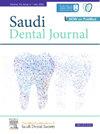Computer guided versus freehand dental implant surgery: Randomized controlled clinical trial
IF 2.3
Q3 DENTISTRY, ORAL SURGERY & MEDICINE
引用次数: 0
Abstract
Objective
This study compares, in terms of rehabilitation and recovery, freehand implant placement using flapless or mini-flap procedures with the use of 3D implant design software and specialized surgical templates among patients who are partially or completely edentulous. A secondary aim is to propose an algorithm for predicting the accuracy of implant placement. Method.
Patients with an alveolar height of at least 7 mm and an alveolar width of at least 4 mm were randomly assigned to two groups. Group I comprised ten patients who received computer-guided dental implant placement, while Group II comprised ten patients who received manual placements. A temporary prosthodontic was immediately inserted onto the implants, which was replaced by a permanent one after 4–6 months.
Results
The study enrolled twenty patients. A blinded, independent assessor evaluated the outcome variables, which included implant failure, marginal bone loss, treatment duration, post-surgical pain and swelling, use of painkillers, surgical time, and patient satisfaction. Pain scores in Group II were significantly higher than those in Group I, but there were no other significant differences. All patients experienced pain after 2 days, but by 7 days, only two patients in Group I and four patients in Group II were still suffering, although this difference was not statistically significant. After 14 days, all patients were asymptomatic.
Conclusion
Although the freehand technique is straightforward for experienced surgeons, surgical guides enhance the accuracy of implant placement, particularly in a deficient alveolar ridge.
计算机辅助与徒手种植牙手术:随机对照临床试验
目的 本研究比较了在部分或完全无牙颌患者中使用无瓣或迷你瓣手术与使用三维种植体设计软件和专用手术模板进行徒手种植的康复和恢复效果。另一个目的是提出一种预测种植体植入准确性的算法。方法:将牙槽高度至少为 7 毫米、牙槽宽度至少为 4 毫米的患者随机分为两组。第一组的十名患者接受计算机引导下的种植体植入,第二组的十名患者接受人工植入。种植体上立即植入临时义齿,4-6 个月后再植入永久义齿。由盲人独立评估员对结果变量进行了评估,其中包括种植失败、边缘骨损失、治疗时间、术后疼痛和肿胀、止痛药的使用、手术时间和患者满意度。第二组的疼痛评分明显高于第一组,但没有其他显著差异。所有患者在 2 天后都感到疼痛,但到 7 天时,只有第一组的两名患者和第二组的四名患者仍感到疼痛,尽管这一差异在统计学上并不显著。结论虽然徒手技术对于有经验的外科医生来说很简单,但手术导板可以提高种植体植入的准确性,尤其是在牙槽嵴不足的情况下。
本文章由计算机程序翻译,如有差异,请以英文原文为准。
求助全文
约1分钟内获得全文
求助全文
来源期刊

Saudi Dental Journal
DENTISTRY, ORAL SURGERY & MEDICINE-
CiteScore
3.60
自引率
0.00%
发文量
86
审稿时长
22 weeks
期刊介绍:
Saudi Dental Journal is an English language, peer-reviewed scholarly publication in the area of dentistry. Saudi Dental Journal publishes original research and reviews on, but not limited to: • dental disease • clinical trials • dental equipment • new and experimental techniques • epidemiology and oral health • restorative dentistry • periodontology • endodontology • prosthodontics • paediatric dentistry • orthodontics and dental education Saudi Dental Journal is the official publication of the Saudi Dental Society and is published by King Saud University in collaboration with Elsevier and is edited by an international group of eminent researchers.
 求助内容:
求助内容: 应助结果提醒方式:
应助结果提醒方式:


